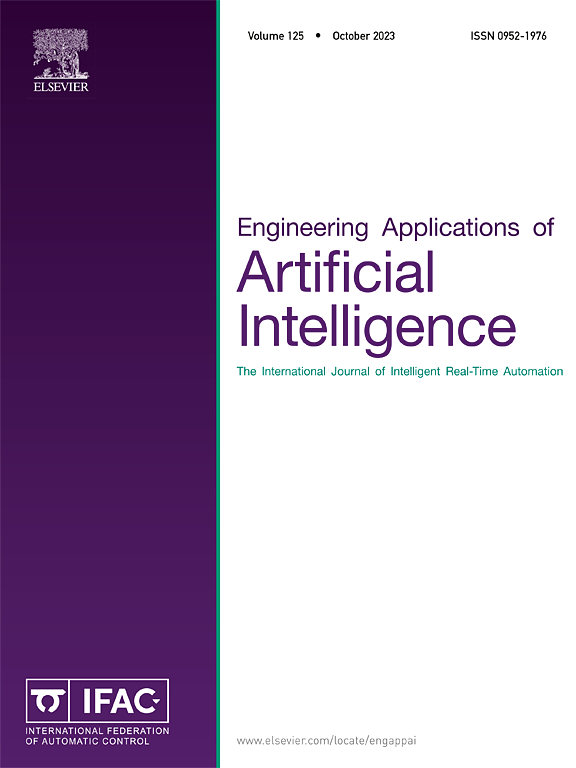利用机器学习算法对太阳辐射数据进行水平到倾斜的转换
IF 7.5
2区 计算机科学
Q1 AUTOMATION & CONTROL SYSTEMS
Engineering Applications of Artificial Intelligence
Pub Date : 2025-04-26
DOI:10.1016/j.engappai.2025.110951
引用次数: 0
摘要
在太阳能工程中,太阳辐射是系统设计算法的主要输入。太阳辐射通常是在水平表面测量的。然而,在大多数太阳能应用中,如光伏,表面要么固定在一定角度,要么连续跟踪太阳,以最大限度地提高能量输入。因此,将太阳辐射数据从水平表面转换为倾斜表面是必要的。传统上,太阳辐射从水平到倾斜的转换是用解析方法进行的。与许多其他科学技术学科一样,机器学习最近也成功地应用于太阳辐射建模,以解决诸如太阳辐射的提前预测等各种问题。在本文中,通过机器学习算法将在水平表面收集的太阳辐射转换为倾斜表面,并与倾斜表面测量的太阳辐射进行比较。目前已有八种不同的机器学习算法用于太阳辐射数据的转换。模型的准确性已根据文献中常用的七个统计指标进行了评估。总的来说,额外树算法得到了最好的结果,如所使用的统计指标,平均绝对误差为7.3219,决定系数为0.9964。根据目前获得的结果,与分析模型相比,机器学习导致了更好的预测。目前的研究强调了这种先进技术的重要意义,强调了它们推动太阳能工程范式转变的潜力。本文章由计算机程序翻译,如有差异,请以英文原文为准。
Horizontal-to-tilted conversion of solar radiation data using machine learning algorithms
Solar radiation is the main input of system design algorithms in solar energy engineering. Solar radiation is usually measured on horizontal surfaces. However, in majority of solar energy applications such as photovoltaics, surfaces are either fixed at certain angles or continuously track the sun for maximizing energy input. Therefore, converting solar radiation data from horizontal to tilted surfaces is essential. Conventionally, conversion of solar radiation from horizontal to tilted is carried out using analytical methods. As with many other disciplines in science and technology, machine learning has recently been successfully applied also to solar radiation modelling to solve various problems such as in-advance forecasting of solar radiation. In the present article, solar radiation collected on horizontal surface is converted to tilted surface by machine learning algorithms and compared to solar radiation measured at a tilted surface. Eight different machine learning algorithms have been presently used for the conversion of solar radiation data. Accuracy of the models has been assessed based on a total of seven statistical metrics commonly used in literature. Overall, extra trees algorithm led to the best results as indicated by the statistical metrics used, for example, the mean absolute error of 7.3219 and coefficient of determination 0.9964. Based on the results presently obtained, it is demonstrated that machine learning led to an improved prediction when compared to the analytical models. The present research highlights the crucial significance of such advanced techniques, emphasizing their potential to drive a paradigm shift in solar energy engineering.
求助全文
通过发布文献求助,成功后即可免费获取论文全文。
去求助
来源期刊

Engineering Applications of Artificial Intelligence
工程技术-工程:电子与电气
CiteScore
9.60
自引率
10.00%
发文量
505
审稿时长
68 days
期刊介绍:
Artificial Intelligence (AI) is pivotal in driving the fourth industrial revolution, witnessing remarkable advancements across various machine learning methodologies. AI techniques have become indispensable tools for practicing engineers, enabling them to tackle previously insurmountable challenges. Engineering Applications of Artificial Intelligence serves as a global platform for the swift dissemination of research elucidating the practical application of AI methods across all engineering disciplines. Submitted papers are expected to present novel aspects of AI utilized in real-world engineering applications, validated using publicly available datasets to ensure the replicability of research outcomes. Join us in exploring the transformative potential of AI in engineering.
 求助内容:
求助内容: 应助结果提醒方式:
应助结果提醒方式:


